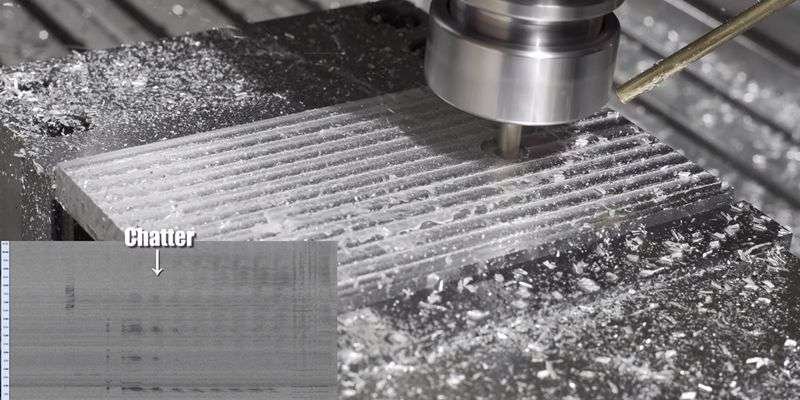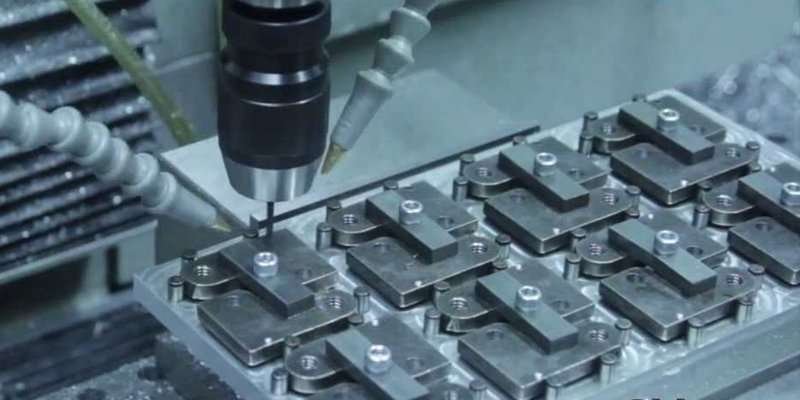ABS plastics are virtually ubiquitous. From automotive parts to medical and healthcare devices and consumer goods, machined ABS parts are reliable and contribute to the durability and functionality of many products.
As a versatile performance thermoplastic, machining ABS plastic is adaptable to additives, and tensile strength makes it an ideal substitute for other thermoplastics.
Table of Contents
ToggleWhat is ABS Plastic?
ABS plastic, or Acrylonitrile Butadiene Styrene, is a thermoplastic polymer commonly used in various industrial applications. It is a versatile material known for its impact resistance, durability, and mechanical strength.
CNC ABS plastics are lightweight and easily molded and shaped into intricate designs. As a versatile performance thermoplastic, its ease of machining, adaptability to additives, and tensile strength make it an ideal substitute for other thermoplastics.
At a Glance at ABS
| Color | Opaque, commonly white or black |
| Processing | CNC machining (low-volume prototypes) Injection molding (mass production) Extrusion (sheets, pipes) 3D Printing (FDM for prototyping) |
| Tolerances | Precise in CNC machining and injection molding Varies with processing |
| Hardness | 70-115 Rockwell hardness |
| Melting Point | 200-240°C |
| Chemical Resistance | Resistant, vulnerable to some solvents |
| Physical Properties | Lightweight, good dimensional stability |
| Environmental | Recyclable, UV-sensitive |
| Applications | Automotive, consumer goods, medical devices |
| Cost | Relatively low-cost material |
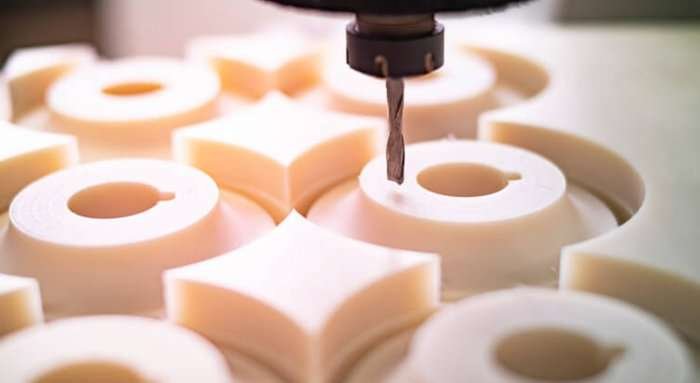
Why Use ABS for Your CNC Plastic Parts?
Due to its favorable characteristics, ABS is a commonly used plastic material for CNC machined parts.
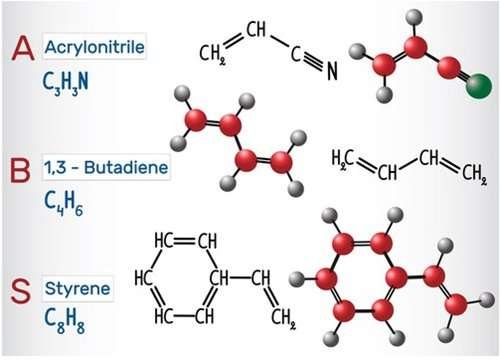
The picture above shows the properties of ABS. Resource
Chip Formation
ABS produces short and easily ejectable chips during machining. These chips are generally smoother and less prone to jamming or clogging the cutting tools.
Cutting Forces
ABS has relatively low cutting forces compared to other engineering plastics, like Polyvinyl Chloride, making it easier to machine. Conferring less stress on the cutting tools and reduced energy consumption during machining.
Machinability
ABS is known for its ease of processing, as it can be machined using various CNC techniques such as milling, turning, drilling, and tapping. It can be shaped and cut precisely and accurately, allowing for complex and intricate designs.
Advantages of CNC Machining ABS
When machining ABS plastics, the versatility of these thermoplastic properties contributes greatly to their popularity across various applications, Here are some key advantages of ABS.
Cost Effective
ABS is a cost-effective material when compared to most engineering plastics. Its affordability, combined with its favorable mechanical properties, makes it a popular choice for various industries. Additionally, the ability to recycle this material helps reduce costs and also aids industries to become more eco-friendly.

Aesthetically Appealing
CNC ABS plastics are smooth and glossy, making them visually appealing. It can be easily painted or coated to achieve desired colors and surface finishes, enhancing the general aesthetics of products. This property is especially useful in making LEGO toys, phone cases, and game controllers.
Lightweight
ABS is a lightweight plastic material. Its specific gravity is lower than that of many other plastic materials, weighing about 1.05 g/cm³, which makes it easy to handle and transport. ABS is often used in applications that require parts to be lightweight, such as in the electronics and automotive industries.
Also, its lightweight nature is one of the reasons why ABS is a popular choice for 3D printing, as it enables the production of light, low-density products like door loners, trim pieces, pipes, and fittings.
Challenges in CNC Machining ABS
Although ABS plastics have numerous benefits that make them a perfect choice for certain applications, it is imperative to note their limitations when producing custom ABS plastic parts.
Poor Chemical Resistance
ABS polymers are not resistant to certain chemicals, including solvents like acetone. Exposure to these chemicals can lead to swelling, deformation, or material degradation. It is crucial to consider the compatibility of ABS with the intended environment or substances it may come into contact with.
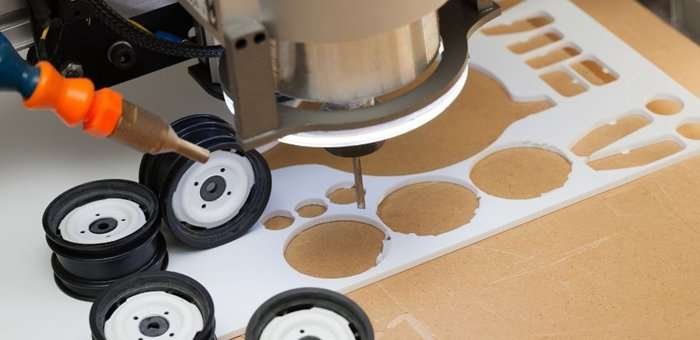
Low Heat Resistance
ABS plastics have a relatively low heat resistance compared to other engineering plastics such as PEEK (Polyetheretherketone). This material has a relatively low glass transition temperature, around 105°C to 110°C. As a result, the plastic may soften, wrap, or deform at elevated temperatures during ABS machining, restricting its usage in high-temperature applications.
Read More: PEEK Machining: A Plastics Guide to Machine PEEK
UV Degradation
One major challenge of ABS plastics’ is their susceptibility to UV degradation. Prolonged exposure to sunlight or UV radiation can cause fading, discoloration, and reduced mechanical properties. Also, it is prone to absorbing moisture if left in humid environments, which can lead to a decline in mechanical strength and dimensional stability.
Design Tips and Practices for Machined ABS Parts
When it comes to designing machined ABS parts, there are a few tips and practices that can help you achieve the best results. These include:
Consider Wall Thickness
For CNC machining ABS parts, it is important to maintain a consistent wall thickness to ensure structural integrity and avoid warping. Recommended wall thickness can vary depending on the complexity and size of the part. For example, the minimum thickness of the wall is 2mm for small parts.
Use Coolants
ABS is known to melt point easily at high temperatures. Coolants are used to control the temperature by reducing the heat generated during the machining process. They provide a barrier between the cutting tool and the material, which helps to dissipate heat, preventing overheating. By keeping the temperature low and constant, coolants also help to improve the overall quality of the machining process.
For machining ABS plastic parts, it’s advisable to use water-based coolants like soluble oil, synthetic coolant, and semi-synthetic oils.
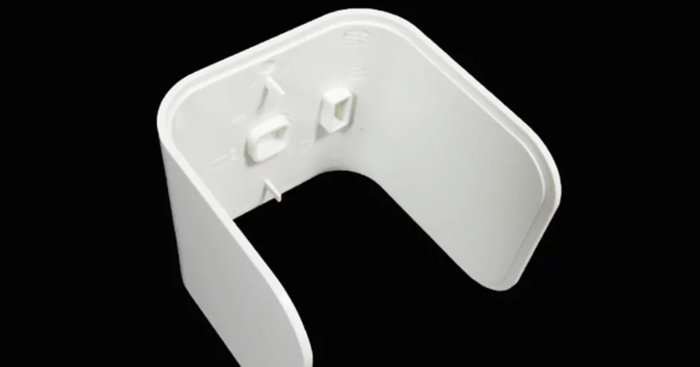
Incorporate Fillets and Chamfers
Adding fillets or chamfers to sharp corners or edges can help reduce stress concentrations and increase part strength. They also make ABS machining easier by preventing the tool from getting trapped in tight corners.
Optimize Part Orientation
Depending on the machining method (e.g., milling ABS or ABS turning), optimizing the part orientation can minimize material waste and tool movements, resulting in a more cost-effective and efficient manufacturing process.
“Consider using lower cutting speeds and higher feed rates to minimize heat generation, as excessive heat can lead to warping and degradation of ABS material during machining.” Guo, a CNC Machining Engineer at XinCheng, also advised.
Surface Finishing Options of Machined ABS Parts

There are several surface finishing options for machined ABS plastic parts, depending on the desired appearance and functionality of the finished product. Some common finishing options for CNC ABS machined parts include:
Vacuum Metallizing
Vacuum metalizing, or vacuum metallization, is a popular surface finishing method often used to improve the physical, electrical, or optical properties of ABS plastic parts. It involves depositing a thin layer of metal, typically aluminum, onto the surface of the plastic part in a vacuum chamber.
The benefits of vacuum metalizing during ABS plastic fabrication include a radiant, highly reflective appearance and resistance to moisture, abrasion, and corrosion. It can also provide added protection against electromagnetic interference.
Bead Blasting
Bead blasting is a process that uses fine beads, such as glass or ceramic, to clean or finish the surface of a material. Propelling the fine beads at high velocity removes any surface contaminants or inconsistencies, leaving you with a cleaner and smoother finish. This process can be particularly useful if you plan on painting or applying any other type of coating on the CNC ABS plastic.
Painting
Painting is a popular choice for CNC machining ABS regarding surface finishing options. Painting allows you to customize your ABS machined parts with various colors, finishes, and designs. Whether you’re going for a vibrant look or a sleek and professional appearance.
Painting can help you achieve your desired aesthetic outcome for your custom ABS plastic parts. In addition to the visual appeal, painting protects your ABS machined parts. The paint is a barrier against corrosion, scratches, and other forms of wear and tear. It helps to prolong the lifespan of your parts.
Alternative Methods for Processing ABS
ABS is a versatile thermoplastic used in CNC machining plastic that offers high mechanical strength, thermal stability, and corrosion resistance. There are several methods for processing ABS, which are as follows.
3D Printing
3D printing is a common method of processing ABS that creates three-dimensional objects by building them layer by layer with a digital file. One of the merits of making ABS block for machining in 3D printing is its ability to avoid deformation, making it suitable for functional parts that require durability and heat resistance.
In addition, 3D printing with ABS plastic empowers designers, engineers, and machinists to enhance their creativity. This process is done by producing customized objects, prototypes, and even replacement parts cost-effectively.
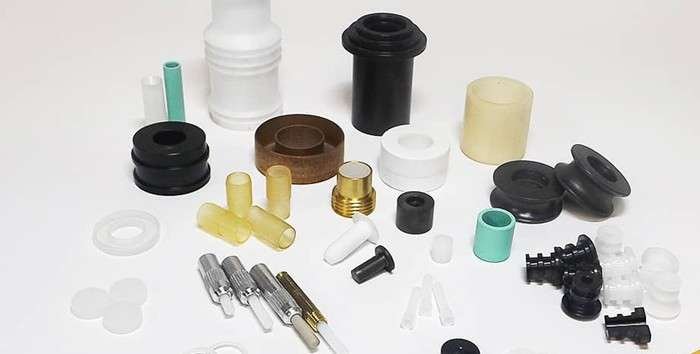
Injection Molding
When using injection molding during machining ABS plastic, plastic pellets are fed into a heated barrel, which melts them into a liquid state. The molten plastic is injected into the mold cavity under high pressure, where it cools and solidifies, taking the desired shape of the mold.
This engineering plastic is particularly suitable for injection molding as it allows for mass production, consistent product quality, and the ability to produce complex shapes with minimal material waste.
Plastic Extrusion
Plastic extrusion is a manufacturing process where plastic is melted and then pushed through a die to create a desired shape. This method allows for the creation of ABS products in various shapes and sizes. Plastic extrusion offers the flexibility to produce them efficiently, whether you need rods, sheets, profiles, or even complex geometries.
Applications of ABS Plastic Parts
Due to their excellent properties, ABS plastic parts have a wide range of applications across various industrial sectors.
Electrical Industry
ABS material is widely used in producing electronic devices and appliances like computer monitors, keyboards, audio equipment, and even mobile phone casings. This use is because of its lightweight and insulative properties, which makes it a suitable choice for coating electrical parts.
Automotive Industry
ABS plastic is used in making the interior and exterior parts of cars, such as dashboard components, interior trim, door panels, and seat backs. Its excellent impact resistance and durability make it ideal for withstanding the demands of the road.
Medical and Healthcare Industry
This material is employed in producing various medical equipment like blood collection tubes, syringes, medical instrument housings, and protective equipment due to its chemical resistance, biocompatibility, and ability to withstand autoclaving.
Get ABS Plastic Parts at XinCheng Machining
Are you finding a reliable manufacturer for your ABS machining projects? Here at XinCheng, you can get high-quality ABS plastic parts. Our precision manufacturing ensures durable components for various industries. Whether you need custom prototypes or large-volume production, we specialize in delivering precise and reliable ABS plastic parts. Our CNC facilities and skilled team ensure exceptional accuracy and efficiency in every project.
XinCheng is also committed to meeting your specifications and exceeding expectations. Trust our plastic CNC services that meet stringent quality standards. Contact us today to discuss your project requirements.
Conclusion
ABS plastic is a versatile thermoplastic largely outsourced due to its lightweight, electrical insulating properties and recyclability. Overall, ABS is still a solid option for several applications as long as the demand for strong and reliable materials increases.
FAQs
What are the different types of ABS grades used in production?
The common types of ABS grades used in manufacturing plastic parts are ABS flame-retardant, injection molding, and extrusion grade.
Are ABS plastics safe to use?
ABS plastic is generally considered to be safe for everyday use. It does not contain carcinogens. Hence, it is a safe plastic for making kids’ toys and other consumer products.
Are ABS plastics expensive?
This material is cost-effective. The price range is between $1.50 and 2.50 per pound.

